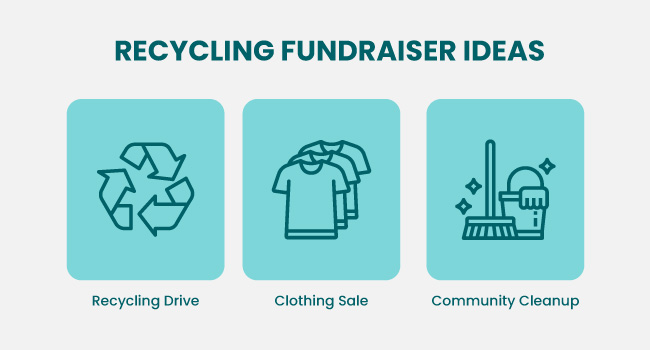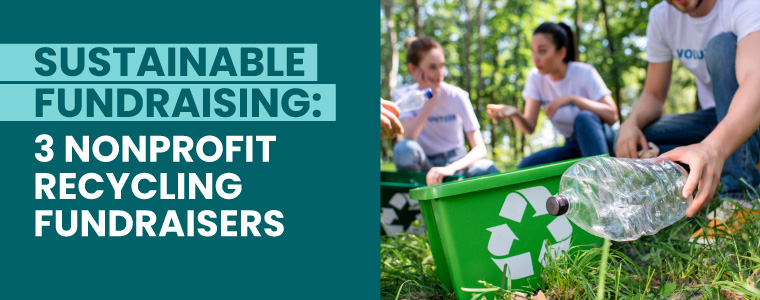Sustainable Fundraising: 3 Nonprofit Recycling Fundraisers
Nonprofit professionals are constantly seeking fresh new fundraising ideas to garner enough monetary support to power their purpose. However, for environmentally-focused organizations, it can be difficult to balance the need for fundraising and the waste that fundraising events produce.
Even if your nonprofit doesn’t specifically deal with environmental issues, prioritizing sustainability and eco-friendliness is still a valuable practice. After all, we only have one planet, and we must all do our part to protect it. This idea is reflected in all industries—for example, 78% of consumers believe that sustainability is important and 55% of consumers are willing to pay more for eco-friendly brands.
Protect the environment and show your supporters that you’re doing your part by hosting a recycling fundraiser. We’ll cover three top ideas in this guide to help your nonprofit focus on sustainability. Let’s get started!

1. Recycling Drive
When most individuals think of a recycling fundraiser, the first idea that comes to mind is the recycling drive. For this event, you’ll ask supporters to collect recyclable materials such as the following:
- Paper: This includes cardboard, paper towels, newspapers, magazines, office paper, and envelopes.
- Plastic: Recyclable plastic includes bottles, food containers, jars, lids, and bags.
- Glass: The most accessible recyclable glass is available in bottle and jar form, but you can also find glass in some types of furniture and appliances.
- Metal: This includes metal cans, copper wires, and other pieces of scrap metal.
- Textiles: It’s estimated that 92 million tonnes of textile waste end up in landfills annually. Encourage your supporters to donate clothing and other fabric to reduce this waste.
- Electronics: This includes smaller electronic items such as phones, chargers, and cables, as well as larger electronic items such as computers, laptops, and TVs.
Your supporters will then donate these items to your nonprofit. You can either set out collection boxes so that they can drop off their items at their convenience or specify a specific drop-off day, depending on which is easier for your organization. Then, you’ll sort through them and take them to a recycling center, which will pay you per pound of recyclable material you collect. This way, your supporters contribute to creating a more sustainable world and your nonprofit receives the funds it needs. It’s a win-win!
If you have too much on your plate to facilitate this donation process, there are organizations out there that are willing to handle the heavy lifting on your behalf. For example, Phill the Box supports clothing drive fundraisers by providing organizations with collection boxes. Their representatives will empty these collection boxes each week and send a check to your nonprofit for every pound of clothing collected. Partnering with an organization such as this will drastically reduce the amount of effort your nonprofit will have to put in to make your event a success.
2. Clothing Sale
Another recycling fundraiser that’s sure to draw a crowd is the clothing sale. Much like a recycling drive, this type of event hinges on your supporters making in-kind donations of new or gently-used items. This time, however, you’ll be planning and hosting a fundraising event to sell what you collect.
Here are the steps to hosting a clothing sale:
- Request donations of new and gently-used clothing from supporters.
- Collect clothing donations from supporters through drop-off or collection boxes.
- Sort through the items and determine which ones can be resold.
- Set a date, time, and location for your clothing sale.
- On that day, display the items for attendees to purchase.
- After the sale, sell any leftover items to a recycling center.
Clothing sales require a thorough marketing strategy, as you’ll need to convince supporters to both donate old clothing and purchase new items during the actual sale. Create promotional materials for both of these tasks. Be sure to release the ones for the donations well in advance to ensure that you receive a good amount of items to sell.
Additionally, if you’d like to level up your fundraising during this event, consider hosting a t-shirt fundraiser alongside your clothing sale. Since individuals will be attending your event intending to buy clothing, they’ll be more receptive to purchasing garments branded to your nonprofit. This will increase your nonprofit’s brand awareness, leading to an increase in future support.
3. Community Cleanup
A community cleanup is a variation of an event-a-thon, such as a swim-a-thon or a read-a-thon. According to 99Pledges, participants in these fundraisers collect donation pledges for certain activities performed. In the case of a community clean-up, participants request pledges for the amount of litter they pick up or the amount of time they spend cleaning.
Popular areas to host a community cleanup include:
- Neighborhoods
- Schools
- Community centers
- Parks
- Beaches
- Rivers and creeks
- Hiking trails
However, your event isn’t limited to these locations—feel free to get creative and pinpoint exactly where your local community needs help! If you know of any areas that have more litter than others, don’t be afraid to ask volunteers to clean up those locations.
As this event is a great exercise in team-building, one way to maximize the revenue you gain is by partnering with a local business. Particularly charitable-minded companies may even be willing to fulfill their employees’ pledges or provide some form of volunteer grant, resulting in greater financial support for your nonprofit.
Bonus Tip: In-Kind Donations
While in-kind donations aren’t strictly a fundraising idea, they relate to the fundraising ideas we’ve mentioned above. In-kind donations are any form of non-monetary donation that can be made to your nonprofit, including items, volunteer time, services, and even software.
Although in-kind gifts may be less flexible than monetary gifts, they allow you to create a more sustainable process for your nonprofit. For example, if you’re seeking auction items, you can request gifts from your supporters. Combine them into gift baskets or raffle baskets and offer them as prizes during your next auction to both save money and be more environmentally friendly.
Aside from using in-kind donations to generate revenue, you can also use them to directly help your beneficiaries. For example, if your nonprofit works with people experiencing homelessness, you could ask for warm clothing donations as the winter season approaches. Or, if you work with animals, you could accept donations of gently-used toys and pet beds.
Aside from helping your nonprofit stand out, centering sustainability will also help boost your nonprofit’s reputation. These efforts show that your organization cares about the environment and the health of our planet, which is especially valuable if your cause is not directly related to these issues. Use these fundraising ideas to set your nonprofit apart from other organizations and garner the support you need.
